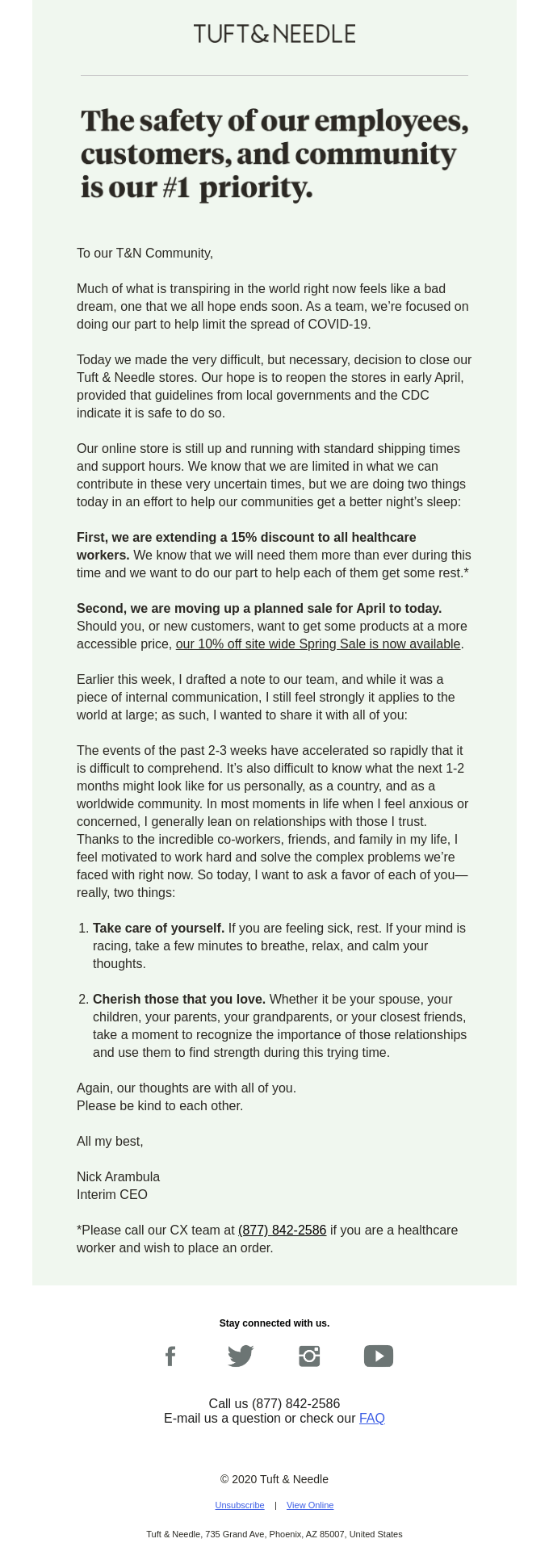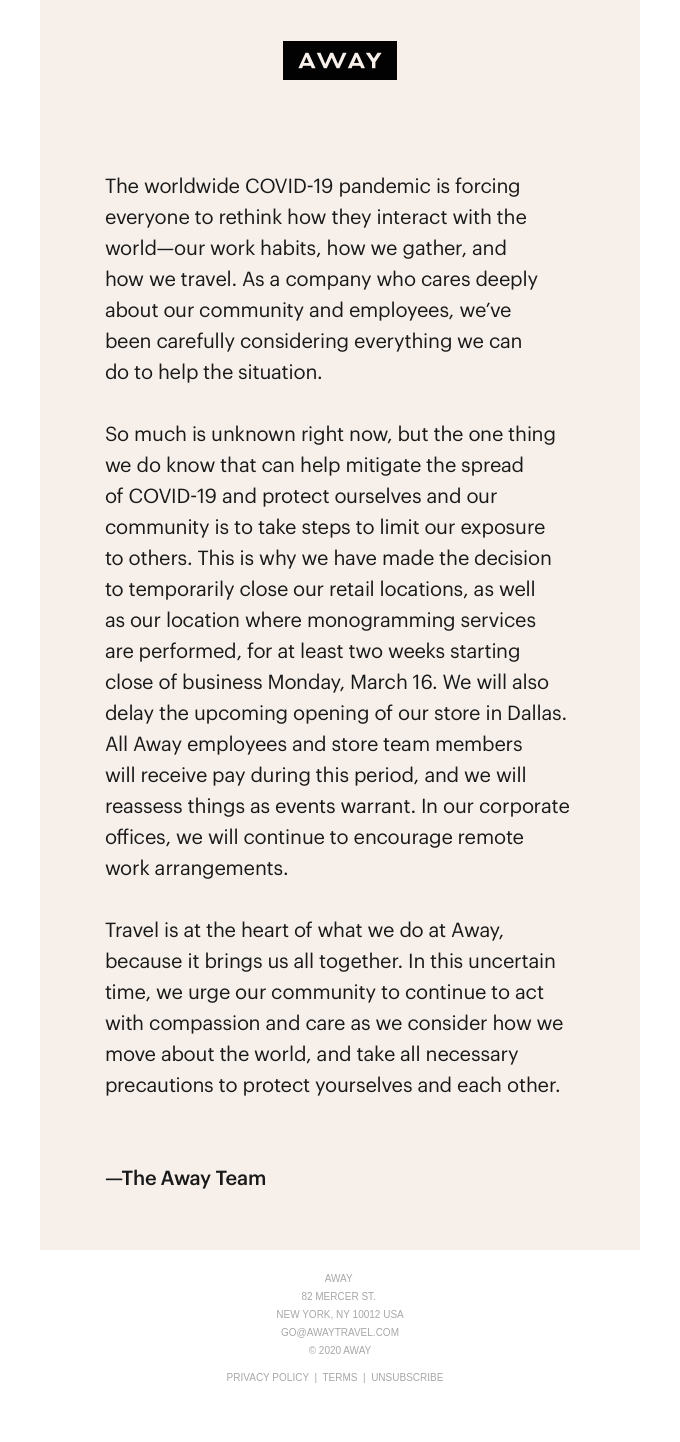Delivering uncomfortable news is never easy. However, as many companies go through layoffs, furloughs, and budget cuts, marketers are forced to recognize tough news and deliver it to others. And, with that tough news, brands face a primary dilemma: How transparent should they be with customers?
Read on to learn about the psychology behind delivering tough news, how companies are doing it, plus real-life examples of their emails.
The psychology behind delivering bad news
You may already be familiar with the different ways people tend to provide negative updates or feedback.
Some cushion bad news by first offering a positive outlook. There’s also the “bad news Oreo,” in which something negative is sandwiched between two happier messages.
Naturally, we want to include some positivity when delivering tough news, and these methods seem ideal when sparing feelings. However, people often don’t want to hear the truth in this way: Bad news may be better received if it’s provided right away.
Psychology experts suggest that neither of the methods previously mentioned—giving good news first or the bad news Oreo—is especially satisfying. In fact, the majority of people want to receive negative news first, opting to receive more positive updates only after they know the worst information. Providing information in this way actually creates the illusion of a happy ending, which is desirable to more people.
Plus, this process provides a foundation for next steps, allowing people to form a plan.
Luckily, your subscribers and customers are no different. If you have tough news to give during COVID-19, they want to hear it sooner rather than later.
Steps we’ve seen businesses take—and what you can learn
There’s no perfect formula when it comes to delivering difficult news to your customers. But there are a few steps we’ve seen brands take, showing they’re putting time and care into crafting these messages.
1. Transparency
It can be hard to be real with your customers, especially when marketing is supposed to be helpful or positive. Still, if you’re forced to make huge changes internally and your marketing doesn’t change, many of your supporters are likely to notice.
In light of this, many companies have been upfront with their supporters, explaining the circumstances at hand. They’ve also taken time to explain how they’re managing these changes and perhaps, most importantly, how customers are affected.
Transparency tips:
- Communicate from an official spokesperson, like a CEO or founder.
- Point out what customers may have heard already (e.g., As you may know, we…).
- If you’re delivering tough news, explain why you had to make the choices you made (within reason).
2. Thoughtful language
When delivering tough news, it’s important to remember words can strongly influence the emotions of your readers, so be thoughtful in how you craft your announcements. You obviously don’t want to sugarcoat the situation, but doom and gloom isn’t necessarily the tone you want to strike either.
As with other marketing announcements, remember that each of your subscribers is going through something different, so be aware of their feelings before making a general statement about quarantine, layoffs, or the economy.
Thoughtful language tips:
- Link to resources (internal or external) your subscribers can use during this time.
- Encourage direct feedback from subscribers.
- Avoid generalizations.
3. Asking for help
When you’re being brutally honest with subscribers—especially if you’re accustomed to sending promotions—it can feel strange to ask for help. But asking for help can look different for different companies.
If you run a restaurant, for instance, maybe you ask that your subscribers consider placing online orders and encourage tips. If you operate a fitness center, maybe you ask for the community’s help in flattening the curve.
For instance, Orangetheory did just that in their email below. And, while they didn’t ask for donations, they did explain that patrons could provide donations if they personally wanted to.

Though long, the email above is thoughtful, honest, and heartfelt. The franchise owners explain that they were forced to lay off 80% of their workforce due to the sudden loss of income. While the email is very sobering, it’s not without a few positive beats:
- The franchise owners explain that they’re offering free workouts online.
- The email explains how patrons can help.
- The messaging provides information for finding further updates.
Tips on asking for help:
- Show how you’ve altered your services to keep customers safe.
- Encourage subscribers to flatten the curve.
- Encourage tipping staff members where appropriate.
More examples of brands giving tough news during COVID-19
Orangetheory isn’t the only brand sending tough emails. We’ve rounded up a few to help you with your own messaging.
1. Tuft & Needle shuts its doors but offers online shopping.
Source: Really Good Emails
Notice how T&F opens with the big news first: They’re closing their doors until it’s safe to reopen. After opening with tough news (from the CEO), they provide some positives:
- They explain the store is still available online.
- They provide a discount for healthcare workers.
- They provide a sale early.
- They encourage good habits among customers.
2. Airbnb informs hosts of its new cancellation and refund policy.
Source: Really Good Emails
Many people make income from Airbnb properties, and these hosts have been dramatically affected by the lack of current travel. Above, Airbnb presents the tough reality that they need to provide full refunds and cancellation requests to those deciding not to travel. Here are some positives from the email:
- Airbnb notes that they only succeed if their hosts succeed, emphasizing their partner relationship.
- The email is from Airbnb’s founders.
- The founders clearly explain their reasons for taking action.
3. Away closes retail locations to mitigate the virus’ spread.
Source: Really Good Emails
Like Airbnb, Away is a company focused on travelers. The email above explains that Away is indefinitely closing its brick-and-mortar stores to provide safe shopping experiences online. Here are some of the positives Away lists:
- The email provides an exact closure date.
- Away explains that employees (including store employees) will continue to receive pay.
- The email encourages a sense of community.
Wrap up
As we face changes in the economic landscape, we’ll likely see unexpected messaging come from some of our favorite brands.
Luckily, many brands have responded to change with grace, emailing subscribers with the updates they need. If you’re considering discussing difficult news with your subscribers, you may find inspiration from the companies above.
Interested in reading more of our COVID-19 content? Find our resources here.








